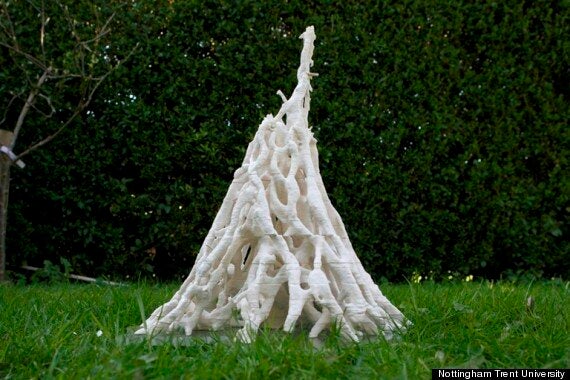In the future buildings may have unusual architects.
Termites.
Well, actually, robotic ants programmed to behave like termites, but who will instead design homes for us.
The idea has emerged out of a new $1.35 million international project to study termites, and learn how we might copy their ability to build habitats with naturally breathable walls.

Above: a 3D printed model of a termite mound
Researchers say that termite mounds are the only natural 'homes' in nature which are able to exchange oxygen and carbon dioxide without losing heat. The result is that termites are able to live in extremely harsh climates where they could not otherwise survive.
The aim of the study is to closely monitor how this works, and potentially come up with building designs or materials for humans that can 'breathe' in a similar way.
As part of the project Dr Rupert Soar, a reader in sustainable technologies at Nottingham Trent University, will digitally scan termite mounds in India. He will then use a 3D printer to create models of the mounds for further study.
The project will also look at how termites behave in a wider sense, and that data will be used to program robotic ants - who will then potentially build new structures for humans.

Above: Dr Rupert Soar at Nottingham Trent University
Dr Soar said that the research was not an attempt to "copy nature" but to copy the process and apply it to new problems.
In a statement he said:
"Current construction thinking is to super insulate our buildings and seal them up tight, essentially separating us from the outside. This saves energy but leads to accumulation of stale and damp air in the building.
"In nature the opposite is true - walls are structured and permeable to allow the passage of gases while retaining the temperature and moisture inside.
"When we breathe, we use the muscles around our lungs to push carbon dioxide out and draw in oxygen in. By doing this, we preserve a delicate balance of temperature and moisture deep in our lungs.
"We believe as a team we have found the same principle in termite mounds in Namibia, except instead of using muscles to breathe, the termites construct a mound which uses the complex energy in turbulent wind to do the same thing."
The project is a joint effort between The Wyss Institute at Harvard University, the State University of New York College (SUNY) of Environmental Science and Forestry, the National Museum of Namibia, the National Centre for Biological Sciences in Bangalore, India, and Nottingham Trent University. It is sponsored by the Human Frontiers Science Program.